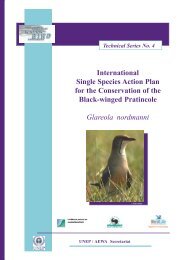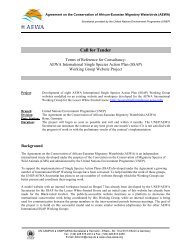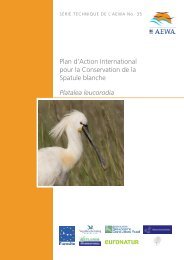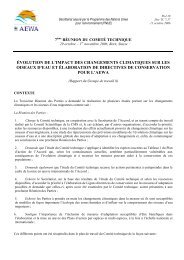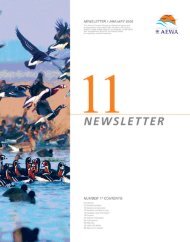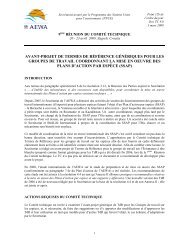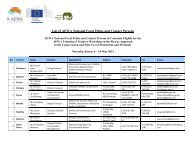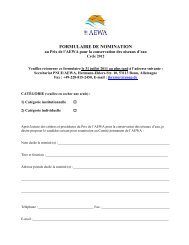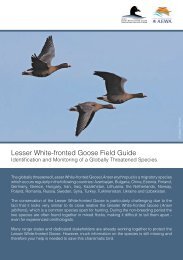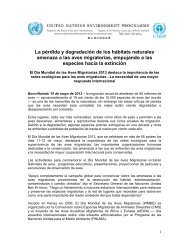International Single Species Action Plan for the ... - AEWA
International Single Species Action Plan for the ... - AEWA
International Single Species Action Plan for the ... - AEWA
You also want an ePaper? Increase the reach of your titles
YUMPU automatically turns print PDFs into web optimized ePapers that Google loves.
<strong>AEWA</strong> Technical Series No. 36<br />
Land abandonment<br />
Staging and wintering grounds<br />
Importance: Medium<br />
Abandonment of traditional agricultural land-management practices is a strong trend in many<br />
countries of central and eastern Europe and Central Asia (e.g. Kazakhstan), and has been a<br />
significant factor in parts of Fennoscandia. In some cases, such as <strong>the</strong> decline in mowing of<br />
coastal and sub-alpine meadows at staging sites around <strong>the</strong> Baltic Sea, this may lead to<br />
deterioration and loss of key Lesser White-fronted Geese feeding habitat due to <strong>the</strong><br />
progressive encroachment of shrubs and trees. However, <strong>the</strong> situation has improved<br />
markedly in <strong>the</strong> Baltic region over <strong>the</strong> last ten years and most actual and potential staging<br />
meadows are managed by grazing/mowing thanks to EU agri-environmental payments (J.<br />
Markkola, pers. comm.). In Kazakhstan, <strong>the</strong> period from 1955 to 1990 was one of intensive<br />
grain production and <strong>the</strong> littoral and near-littoral areas of all key lakes were regularly<br />
cultivated and sown with grain. During <strong>the</strong> last 10 to 15 years, however, much of this land has<br />
been abandoned and <strong>the</strong> distances to <strong>the</strong> main goose feeding areas have increased to 10-20 km<br />
or more (S. Yerokhov, pers comm). In Sweden, hay cutting in Norbotten county has declined<br />
from 200,000 ha in 1927 to about 1,000 ha nowadays. Most of <strong>the</strong> land <strong>for</strong>merly managed <strong>for</strong><br />
hay was located along <strong>the</strong> river-valley migration routes once used by Lesser White-fronted<br />
Geese (M. Björkland, pers comm).<br />
Overgrazing<br />
Breeding grounds<br />
Importance: Local<br />
Over-grazing of tundra vegetation by semi-domestic Reindeer Rangifer tarandus may<br />
threaten <strong>the</strong> quality of breeding habitat <strong>for</strong> <strong>the</strong> Fennoscandian population, though impacts<br />
appear to vary from country to country. For example, data from <strong>the</strong> Swedish county of<br />
Norbotten do not indicate any increase in overall reindeer numbers during <strong>the</strong> period when<br />
<strong>the</strong> Lesser Whitefront population crash occurred (M. Björkland & S. Gylje, pers comm),<br />
while in Finland, reindeer numbers doubled between <strong>the</strong> 1970s and 1990s and <strong>the</strong> adverse<br />
effects on vegetation can clearly be demonstrated (T. Lehtiniemi/BirdLife Finland, pers.<br />
comm.).<br />
Pollution of wetlands/waterbodies<br />
Staging and wintering grounds<br />
Importance: Local<br />
Point-source and/or diffuse pollution of wetlands and water bodies may be a locally important<br />
cause of habitat degradation, but <strong>the</strong>re are few if any documented cases that relate specifically<br />
to Lesser White-fronted Geese.<br />
(d) Potential genetic introgression of White-fronted Goose, Barnacle Goose<br />
and/or Greylag Goose DNA into <strong>the</strong> wild Fennoscandian population from<br />
captive-bred, supplemented/reintroduced birds.<br />
Genetic studies have shown that a proportion of individuals within <strong>the</strong> captive breeding<br />
populations used <strong>for</strong> <strong>the</strong> Finnish and Swedish supplementation/reintroduction programmes are<br />
carrying DNA of o<strong>the</strong>r goose species, notably Greater White-fronted Goose 6 (Ruokonen et al.<br />
2000, Ruokonen 2001, Ruokonen et al. 2007). The percentage of captive-reared birds<br />
carrying alien genes in <strong>the</strong> Swedish captive stock was estimated at 36% (Ruokonen et al.<br />
2007). Combining his breeding notes and genetic data, Tegelström assumed that <strong>the</strong><br />
6 Lesser White-fronted Goose individuals found to be carrying genes of Greylag Goose Anser anser have never<br />
been used <strong>for</strong> reintroduction in Sweden (T. Larsson, pers comm).<br />
<strong>International</strong> <strong>Single</strong> <strong>Species</strong> <strong>Action</strong> <strong>Plan</strong> <strong>for</strong> <strong>the</strong> Conservation of <strong>the</strong> Lesser White-fronted Goose 33



